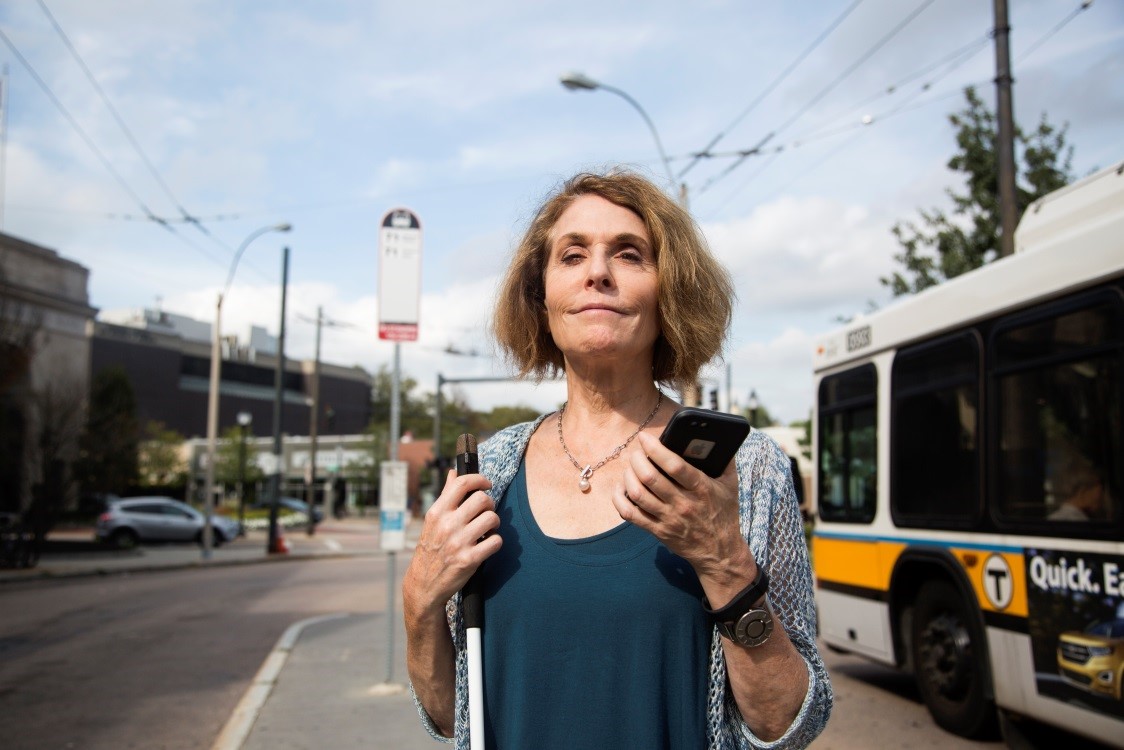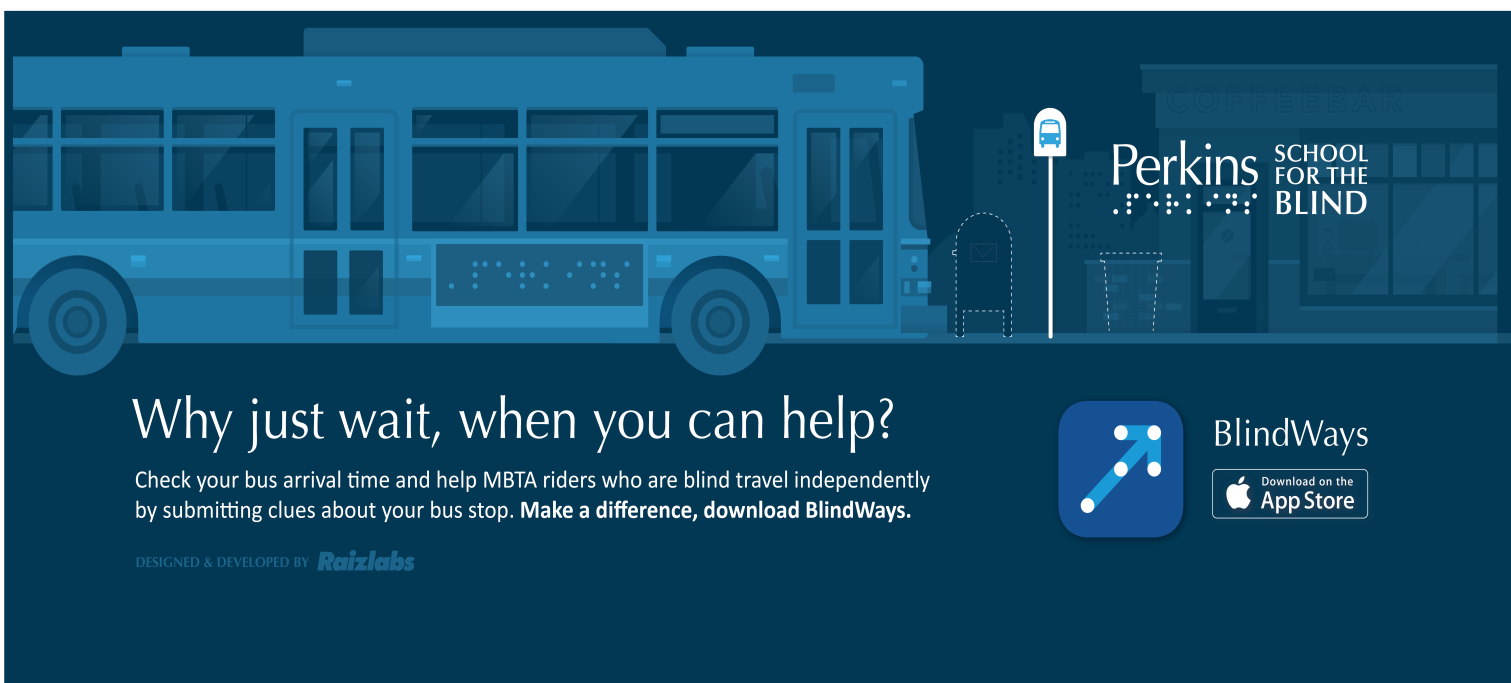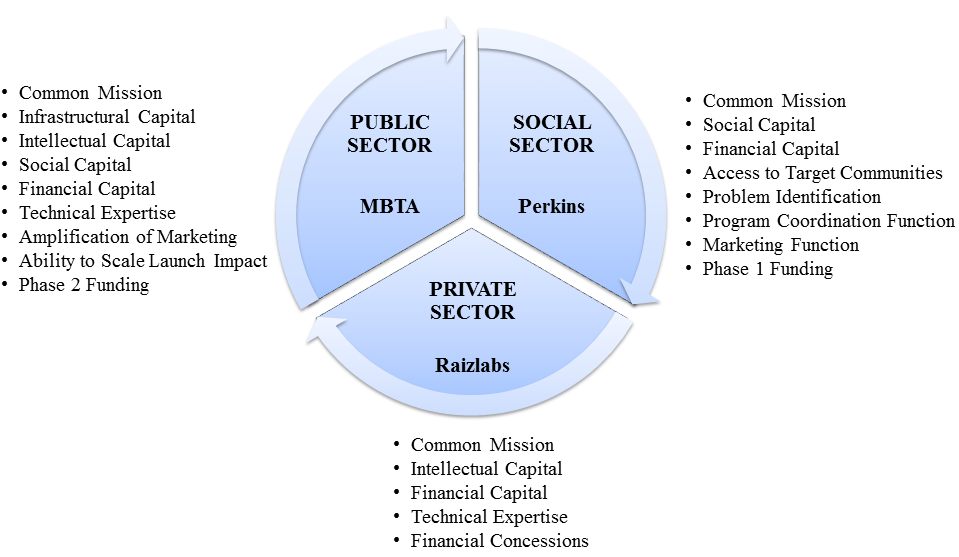Executive Summary
Solving the world's toughest social challenges requires everyone to be at the table. In this article, we present a case study from the City of Boston in which three partners, from the non-profit sector, the private sector, and the public sector, collaborated to design a smart city solution for helping the visually impaired to find and navigate bus stops within the public transportation system. The solution is an accessible smart phone micro-navigation application based on crowdsourced bus stop navigation clues and an IoT-enabled bus stop location and positioning system. The cross-sector partners included in the project are the Perkins School for the Blind, the Massachusetts Bay Transportation Authority (MBTA), and Raizlabs. The article outlines the critical success factors which were important for the success of this cross-sector collaboration.
The Challenge
Imagine missing your bus, despite the fact that you were standing just 30 feet away from the bus stop -- all because you couldn’t see it. This is a real challenge faced by visually impaired Massachusetts Bay Transportation Authority (MBTA) commuters whenever they try to use the approximately 8,000 bus stops in the Boston metro area. A quote offered by a visually impaired MBTA commuter reflects the problem, “I try to use my cane to find bus stops but then usually ask people to double-check. Sometimes I miss my bus.” Dubbed the “last 30 feet of frustration”, the problem exists because current GPS navigation technology is only able to guide users to within a 30-foot radius of a precise destination. While this limitation does not pose a problem for the sighted commuter, for blind and visually impaired commuters these micro-navigation capabilities are critical. In response to this challenge, a cross-sector team from the Massachusetts Bay Transportation Authority (MBTA), Perkins School for the Blind, and Raizlabs envisioned and designed BlindWays, a micro-navigation solution which closes the GPS navigation gap, to bring commuters within a cane’s length of their precise destination

BlindWays Commuter
The Solution -- Smart, Connected, Inclusive Cities
In Phase 1 of the BlindWays project, the team developed an accessible micro-navigation app and crowdsourcing platform that collects navigation clues, which are contributed via the app by both sighted and visually impaired citizens. Citizens can enter information about the location of any physical landmarks, such as trees, driveways, fire hydrants, or benches, which are situated close to the bus stop. The landmarks offer tangible, physical clues which help the blind commuter to navigate more precisely to the bus stop. The navigation clues enable the commuter to form a mental map of the landmarks that they may encounter as they travel toward or away from the stop. Through the BlindWays crowdsourcing platform, citizens have contributed physical landmark clues for approximately 5,300 of Boston’s 8,000 bus stops. In conjunction with the crowdsourced clues, the BlindWays app also leverages real time, predictive information on bus arrival times, data currently available through the MBTA system, which tells the user when the bus will arrive to the stop.
In Phase 2 of the BlindWays project, the team is piloting the use of IoT (Internet of Things) technology for enabling micro-navigation. To do so, Bluetooth beacons are being mounted directly on the bus stops. The beacons enable the transmission of a location and positioning signal from the bus stop. As commuters approach the stop, once the beacon signal is detected, their phone switches from the distance estimates provided by the GPS navigation systems to the beacon distance estimates to facilitate more precise micro-navigation. The beacons transmit a signal to the app, which provides the commuter with information about their distance from the bus stop, via both verbal and vibrating notifications, as they move closer to or further away from the stop. While the crowdsourced navigation clues are subjective reference points entered by other commuters (e.g. “To the left of the stop there is a Bike Rack” or “Before the stop there is a fire hydrant”), because the beacons are mounted directly on the bus stop, they provide the commuter with an objective estimate of their distance from the bus stop. This feature augments the capabilities provided by the crowdsourced clues and enables the visually impaired commuter to get even closer to the bus stop.

Citizens can contribute navigation clues to BlindWays
Challenges and Critical Success Factors for Cross-Sector Collaboration
Social issues are complex problems which require cross-sector collaboration because they impact multiple stakeholders, because numerous organizations have partial responsibility for addressing the problem, and because no single sector has access to all the resources needed to solve the problem. However, while these collaborations hold the potential to generate significant shared value, they are also fraught with the potential for failure. Challenges include ideological clashes, contradictory organizational objectives, non-viable economic models of cooperation, and difficulties in the operational and logistical coordination. The partners in the BlindWays cross-sector collaboration found that three main factors were critical to the success of their partnership (Kania & Kramer, 2011):
- Common Mission
- Collaborative Process
- Complementary Resources
Common Mission
Throughout the literature on cross-sector collaborations, the importance of all partners having a common mission and a shared vision of the goals and priorities of the partnership has consistently been highlighted as a critical success factor (Kania & Kramer, 2011). All three partners in the BlindWays project share a deep commitment to leveraging technology as a tool for social innovation and to creating inclusive and accessible cities and communities. Founded in 1829, Perkins is a non-profit organization and is the oldest school for the blind in the United States, which boasts Helen Keller as a past student. The BlindWays project is led by Perkins Solutions, which is the division of Perkins School for the Blind which focuses on pursuing new opportunities for leveraging emerging technologies to help solve accessibility challenges for the visually impaired. Beyond their internal commitment to creating an inclusive and accessible society, in 2016 Perkins launched a public campaign called BlindNewWorld to promote its mission to create a more inclusive and accessible world for the visually impaired. The second partner, the Massachusetts Bay Transportation Authority (MBTA) believes that they have a commitment and an obligation to provide transportation services to one hundred percent of the population, regardless of physical ability. This commitment continues to be demonstrated by investments in their Program for Accessible Transportation Infrastructure (PATI) project, an initiative which falls under the MBTA’s Department of System-Wide Accessibility (SWA). The third partner, Raizlabs, has as its stated impact-driven mission: “To improve lives through design and technology.” Raizlabs lives out this mission by allowing employees to volunteer to be staffed on projects which align with their personal interests and values. As an example of Raizlab’s alignment with the project mission, in the BlindWays project one of the Raizlabs development team leads, who opted to work on the project, was himself legally blind.
Collaborative Design Process
In cross-sector partnerships, the ability to coordinate activities through a joint problem-solving process is also a critical success factor. Every design process goes through three main stages: Inspiration, Ideation, and Implementation (Brown, 2008). In the BlindWays project, all three partners jointly participated in every stage of the design process, with each partner playing critical roles at various stages in the process. The key to the project’s success was that each partner was able to provide their unique expertise for various sets of activities, but did so in a coordinated fashion, so that the collective impact was greater than the sum of the individual parts.
The inspiration stage of the design process focuses on needs-finding and involves immersion in a user community to discover an unmet need and understand the users’ problems and challenges. In the inspiration stage, Perkins School for the Blind, surfaced a challenge faced by their core constituents, the community of blind and visually impaired commuters. Perkins committed to identifying a solution that could be delivered within 18 months, and sought a systems development partner to help create the solution. Next, the ideation phase focuses on brainstorming new ideas and exploring possible solutions to resolve the challenge. In the ideation phase, Raizlabs, the private sector partner, provided the systems development expertise for the developing the proposed solution. Finally, during the implementation phase the solutions are prototyped, tested, built, and delivered to the user community. Prior to the BlindWays project, the MBTA had already made investments in their PATI (Program for Accessible Transportation Infrastructure) project which involved surveying all of their 8,000 bus stops. During Phase 1 of the project, MBTA was able to leverage their existing System Wide Accessibility team, and add to the duties of their surveyors, in order to aid in implementing navigation clues for 2,000 bus stops. In Phase 2, the project direction was inspired by the MBTA’s thought leadership and experimentation with using emerging beacon technology to facilitate accessible and inclusive public transit. In this phase, all three partners simultaneously contributed to the co-design of the beacon-enabled micro-navigation capability, with Perkins representing the lead users, Raizlabs as the developer, and MBTA responsible for the implementation of the beacon technology and sensing infrastructure across the bus system. For any cross-sector collaboration coordination and communication are both vital for managing the collaborative process. During Phase 1 of the project, Perkins served as the “backbone” organization which provided this coordination role and took responsibility for driving the project to a successful completion. During Phase 2 that role was assumed by the MBTA. Throughout the project Raizlab’s use of an agile software development process enabled all partners to share and receive project updates on a bi-weekly basis; a communications strategy which ensured that all the partners remained informed and involved.

Common Mission and Complementary Resources
Complementary Resources and Cost-Sharing
Cross-sector collaborations have become increasingly important as a strategy for tackling challenging social issue because they leverage the “linking or sharing of information, resources, ties, and capabilities by organizations in two or more sectors to achieve jointly an outcome that could not achieved by organizations in one sector separately” (Bryson, Crosby, & Stone, 2006). This project was successful because of the complementary financial, intellectual, reputational, and infrastructural resources which were contributed by the three partners. As the non-profit sector partner, Perkins School for the Blind, not only surfaced the challenge but also provide the $750,000 funding for Phase 1 of the project, based on funds they received from the Google.org Impact Challenge Disabilities grant. Raizlabs contributed their design and development expertise in app development, web development, and emerging technologies such as Artificial Intelligence, Virtual Reality, and the Internet of Things (IoT). In addition, because of Perkins’ status as a non-profit and the project’s alignment with Raizlab’s impact-driven mission, Raizlabs supplemented the project by making financial concessions to complete the project at a discounted rate compared to their standard commercial pricing. For the project MBTA contributed the data set containing the essential information on bus stop locations, which they made publicly available via through the General Transit Feed Specification (GTFS), which defines a common format for sharing public transportation information. Throughout the product development process, Perkins recruited members of their visually impaired community to serve as product testers who could provide feedback to the Raizlabs design and development team. During the implementation rollout MBTA was able to contribute visibility to the project with the participation of the senior leadership of the MBTA and MassDOT. In addition, for 30 days MBTA contributed advertising space on 400 buses to facilitate a Perkins marketing campaign for the project launch, which they amplified through their MBTA social media channels. The campaign featured a call to action for commuters to enter clues for their bus stops. While Phase 1 of the project was funded by Perkins, the non-profit partner, Phase 2 of the project, which encompasses the pilot implementation of the beacon-enabled micro-navigation capability in the BlindWays app, is being funded by the MBTA, the public sector partner.
The Outcome
In September 2016 Perkins made the BlindWays app available for free on the App store and launched it at -- where else? -- a bus stop! Perkins sponsored a press event and invited MassDOT and MBTA to participate and amplify the launch via their marketing communications. The community-driven collaboration among citizens, Mass Department of Transportation, the Massachusetts Bay Transit Authority, Raizlabs and various other local organization and Perkins made a huge splash in the news media and social networks. Today over 5,300 MBTA bus stops have BlindWays clues, with a goal of finding enough citizens and volunteers to enter navigation clues for all 8,000 bus stops. Pilot testing for the beacon-enabled micro-navigation solution is also well underway. Currently, beacons have been mounted on the stops along the Route 70 (Cedarwood, Market Place Drive, or Central Square, Waltham-University Park) and Route 71 (Watertown Square-Harvard Station) bus lines. With thousands of BlindWays app downloads by users and clue contributors -- blind as well as sighted -- the mission to make the Massachusetts transportation system inclusive and accessible for all continues, with ongoing efforts to inform both the blind and sighted communities about this novel mobility-enhancing social innovation.
The Opportunity
The Internet of Things (IoT) is being hailed as the next technological revolution and will generate many new entrepreneurial opportunities, business models, and solutions to some of the world's toughest challenges. To inspire and incubate technology-driven opportunities for social innovation Babson College and Verizon have partnered to create the IoT For Good Lab. The lab provides resources to encourage inter-disciplinary, cross-sector teams of entrepreneurial thinkers, engineers, and designers to envision and experiment with ideas for generating social value using the Internet of Things (IoT), human-centered design, innovative engineering, and creative business models.
Works Cited
Brown, T. (2008). Design Thinking. Harvard Business Review.
Bryson, J. M., Crosby, B. C., & Stone, M. M. (2006). The Design and Implementation of Cross‐Sector Collaborations: Propositions from the Literature. Public Administration Review, 66(s1), 44–55.
Kania, J., & Kramer, M. (2011). Collective Impact. Stanford Social Innovation Review. Winter.
Author Bios
Jennifer Bailey PhD
Faculty Director, IoT For Good Lab, Babson College.
Assistant Professor, Technology, Operations and Information Management, Babson College.
Follow at www.babson.edu/IoTforGood
Luiza Aguiar
Executive Director, Perkins Solutions, Perkins School for the Blind.
Follow at http://www.perkins.org/solutions/featured-products/blindway
David Block-Schachter
Chief Technology Officer, MBTA.
Follow at https://www.mbta.com/accessibility
Greg Raiz
Founder and CEO, Raizlabs.
Follow at https://www.raizlabs.com/


